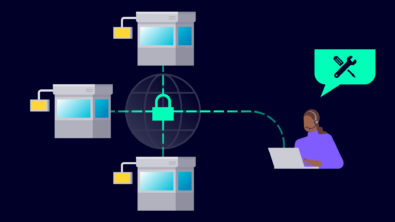CAD in the Cloud, how does it fit in your digitalization efforts?

CAD in the Cloud – What’s happening at the moment? Talking to engineers from a wide variety of industries, I found it interesting that their companies are all having discussions on the value of introducing cloud solutions into various parts of the business and invariably the topic of CAD in the Cloud will rear its head. So, I thought I would share some thoughts on the topic. But, before we dive into any discussion about the pros and cons, what exactly are we talking about under the umbrella topic of CAD in the Cloud?
Well, in mechanical design CAD can mean creating either 2D or 3D design data, for electronic design can be schematic or printed circuit board (PCB) layout data, electrical engineers look at schematic diagrams, industrial designer’s 3D designs and rendering (pretty pictures), so the topic of CAD has a myriad of meanings. But fundamentally all these disciplines are looking at creating a definition of the final product using software tools presented to the designer or engineer, so delivering those tools through the cloud should be a no-brainer, right?
Well, maybe, but I think you need to be clear why you would want to deploy your CAD solution that way, what do you want to gain?
Looking at the history of CAD the concept of cloud and cloud computing isn’t new. At Siemens we have lots of customers who have maintained a central installation of their software and virtualized their environments allowing users around the world to access a single source of both data and software. So private cloud use of products has been around for years.

So why is CAD in the Cloud such a hot topic?
Some vendors will suggest that this is all about reducing installation times, zero install solutions, or access anywhere. While that gives some value, the big question is how much of an overhead is installation and software maintenance? If your software vendor has worked on their tools to install and update versions to streamline the process, then your gains from using zero install software that is managed by somebody else outside of your control are negligible. With today’s compute technology running your companies CAD solution on a laptop or tablet style device is a reality, so location becomes less of an issue, in fact running locally overcomes that annoying situation where you just can’t get wireless access at the point you have that great idea you want to capture.
So, what are the opportunities?
As companies fight to remain competitive and deliver exciting new products there is an increasing trend to digitalize the processes and build upon a digital twin of the product from initial concept through to production. The digital twin becomes the basis for product decisions, it allows analysis and what-if studies without investing in costly physical prototypes that end up in the trash, and importantly it brings together all disciplines that are needed to build the product.
This is where having a cloud-based engineering infrastructure does help, not just CAD in the Cloud, but an engineering platform which brings together the various development disciplines across the organisation to deliver a higher level of visibility to tackle the collaborative development of new products.
A cloud-based engineering infrastructure can bring the benefits of having scalable compute power for performing complex analysis (CAE) along with the benefits of the visibility of core product data between, mechanical, electrical and electronic domains. You need the ability to see and react early, making decisions to about product form and fit early before too much cost is sunk into a project to get the best solution rather than later in the cycle when it is costly, and you are often forced to compromise on product choices.

To be clear, I am not saying CAD on Cloud is a bad step, in fact it is one of the tools we have as a cloud ready solution, but you need to decide what you are looking to achieve overall. Importantly you should be free to implement technology at your pace, you should not be pushed by a vendor into a solution because it suits them. If you want to run CAD on your desktop and Simulation or data management in the cloud, or all cloud, or any other mix, that is your decision to suit your business needs and you should be free to choose at any time.
Personally, I believe that to maximize the value the cloud brings you need to look at the whole product development process. With Siemens cloud solutions we bring together solutions across disciplines to help our customers to innovate faster, digitalizing their processes, and be more responsive to customer and market demands, but we also allow you to decide which strategy you want to use for your technology deployment.
So, it’s about more than just streaming CAD through a browser from a cloud provider, the real value comes from leveraging the power of the cloud to help you develop better products for your customers. Let’s move the discussion from CAD in the Cloud to Product Development in the Cloud.



Comments